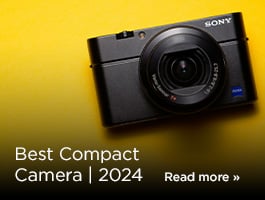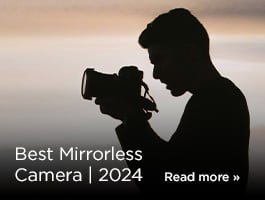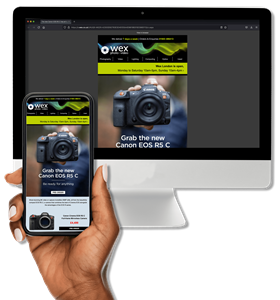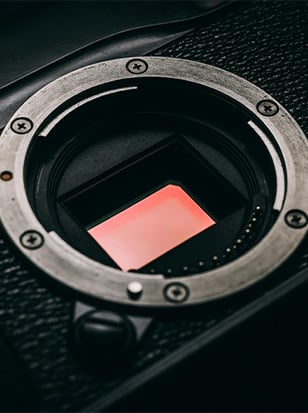
Back in the 2000s, disposable cameras were around £5 a pop. They’re now £20 each. I spent £17 on a refurbished disposable camera lens on eBay. So straight away, assuming the lens is in any way decent, I’m already quids in.
The lens element has been prised from a single-use camera and stuck into a 3D-printed chassis that, frankly, looks like an Oreo. It’s not what you’d consider a quality product, and there’s little I can do in-camera to produce sharp, technically proficient images. But that’s not the point of a disposable camera.
If you’ve used disposable cameras, you probably like the grainy, almost off-putting look. And the images taken on them capture something simply different to your digital camera or your phone. You get them back from Boots and they bring you joy, triggering all the memories of your wholesome trip to the beach or that blurry festival weekend.
But we’re not here to talk about whether disposable cameras (and film) are better than or evoke a greater sense of nostalgia. We’re here to talk about a £17 lens and whether it was a complete waste of money.
It has a 32mm fixed focal length, which, thanks to Fuji’s X-mount 1.5x crop factor, gives us about 48mm in full-frame terms. So, a nice standard-ish field of view. There’s no focusing ring. Disposable camera lenses are designed to keep everything acceptably sharp from about 1 metre (sometimes 1.5m) to infinity. It has a small, fixed aperture — probably f8 to f11 — which gives a wide depth of field, meaning that most subjects should be in focus as long as they’re not too close or too far.
Since there are no electronic contacts, my Fujifilm X-T3 would not fire. But that’s not an issue; just go into settings, select the “Shoot Without Lens” mode, and problem solved. In fact, just like a disposable camera, there are no frills or fuss. Just point and shoot.
The results
I found that I needed to boost the ISO quite a bit, but it turned out fine in the end. Most disposable cameras use ISO 800 film, and the X-T3 can handle that – though I often find the X-T3’s ISO noise messy. If anything, it added to the look. The lack of aperture control added an interesting challenge. There’s a softness around the edges of most images and once I got used to it, I actually liked it.
I was shooting in RAW, which gave me the option to clean up images if my ISO or shutter speed choices weren’t optimal; something you obviously can’t do with a disposable camera!
It’s important to note that this lens does give that signature disposable camera look; imperfections like softness pretty much in every photo and chromatic aberrations and whatnot. But it doesn’t give the colours you might expect from the film. But that’s fine because you can whack on a Fuji film simulation or try a film recipe from Fuji X Weekly.
Just like with any film camera, part of the joy is not necessarily knowing how the picture will turn out. Generally, that means you should take a bit of time to craft your images (unless you’re like Matt Stuart, who can just fire off film and nail most shots — see this video). But at first, I was snapping anything and everything, way past the exposure limit of single-use cameras, and hoping there’d be something decent. Perhaps that’s a me-problem and I should be trying harder with my photography.
In fairness to myself, my initial trigger happiness did simmer out once I’d had time to understand what the lens had to offer. And that’s when I started enjoying the look and feel.
So, was it worth it?
Honestly, yes. It was fun. I have some images that I enjoy that do give me the disposable camera aesthetic. I love how compact and lightweight it is. The X-T3 isn’t exactly a big camera but using this lens essentially turns it into a compact camera. You don’t go out with this lens trying to take tack-sharp images but rather to experiment with what it can do.
I liken it to the growing number of professional cinematographers using refurbished vintage lenses on their modern cinema cameras. They want these lenses because of their uniqueness. For example, director Zack Synder is a well-documented user of vintage lenses, most notably taking a consumer-level 1960s Canon 50mm f0.95 rangefinder lens and pairing it with a RED Monstro digital camera to film Netflix’s ‘Army of the Dead’.
Will I use this sort-of vintage lens again? I mean, I won’t be reaching for it daily, but if I’m going out with my camera with little care for technical proficiency — just a weird, funky look — then hell yeah. After all, isn’t that Lensbaby’s whole deal? And those lenses cost a damn sight more than £17.
And, if there is a point to this lens, it’s that it's kind of environmentally friendly. When you give your disposable camera to the person at Boots or Snappy Snaps, they take the film out and then bin the rest. At least this way — assuming the eBay seller is conscious of waste — one tiny piece of that single-use camera can be re-used.
Disclaimer: We strongly advise against disassembling disposable cameras yourself. These cameras contain a capacitor that stores electrical energy, which can give a harmful shock if mishandled.
Now, while we don’t sell this lens, we do offer a huge range of secondhand kit. Remember, great shots aren’t just about having the latest gear — it’s the person behind the camera that makes the difference. There are plenty of older lenses out there with unique characteristics and the ability to produce stunning images. Explore our range and find one that works for you!
About the Author
Leo White has been a member of the Wex Photo Video team since 2018, working in a variety of roles ranging from the contact centre to the product setup team. With both a photography BA and MA, Leo has a wealth of knowledge he's ready to share.

























